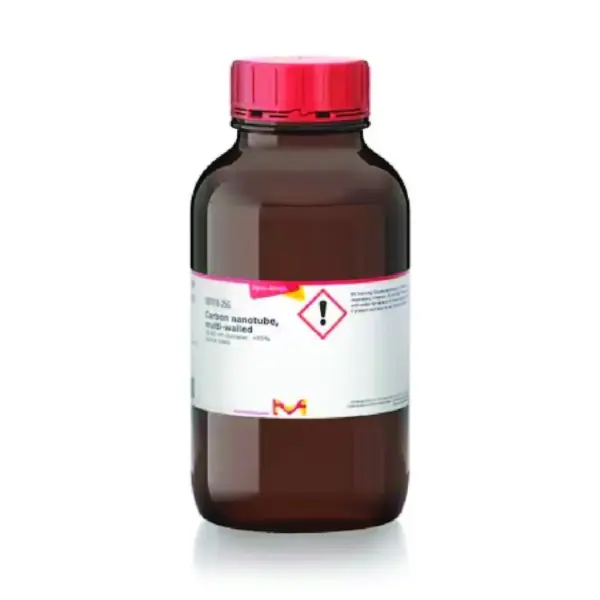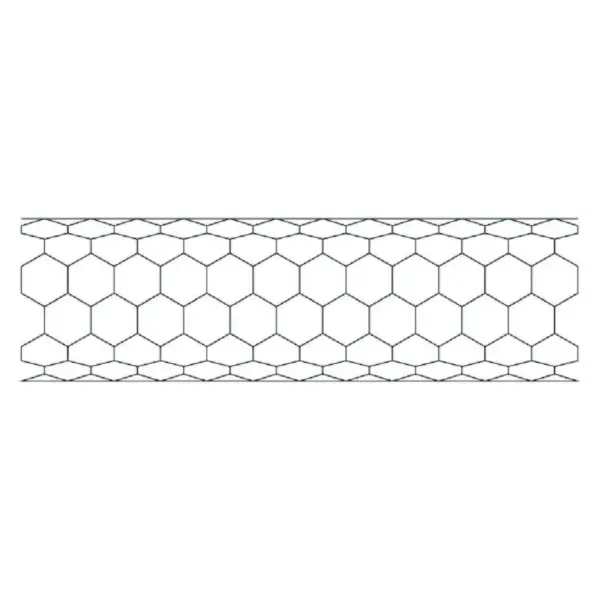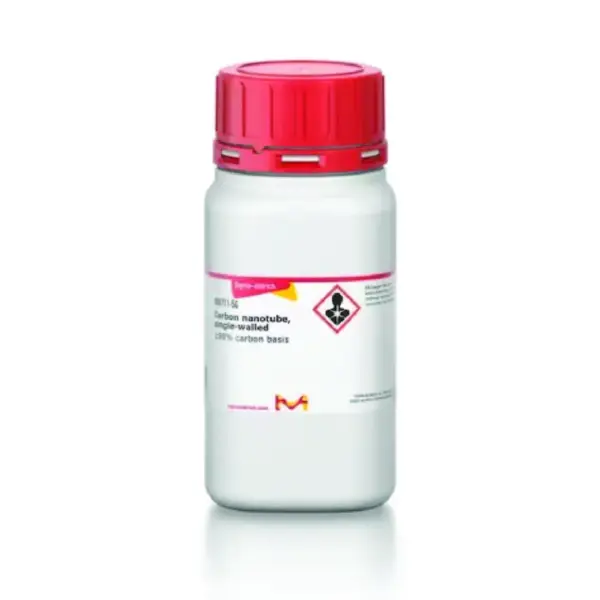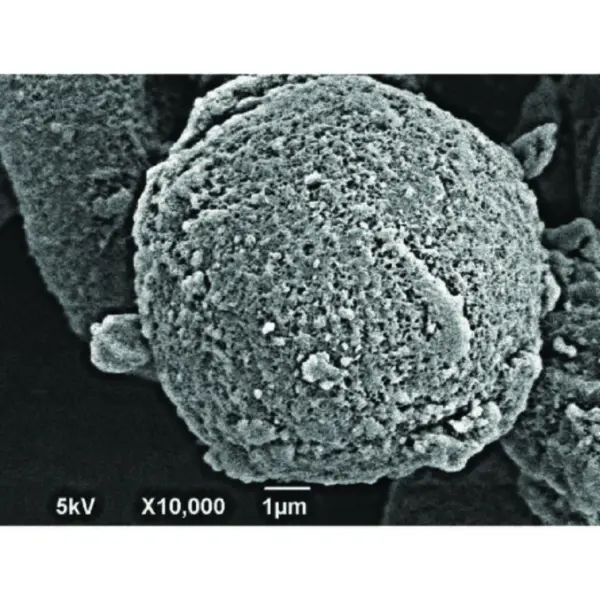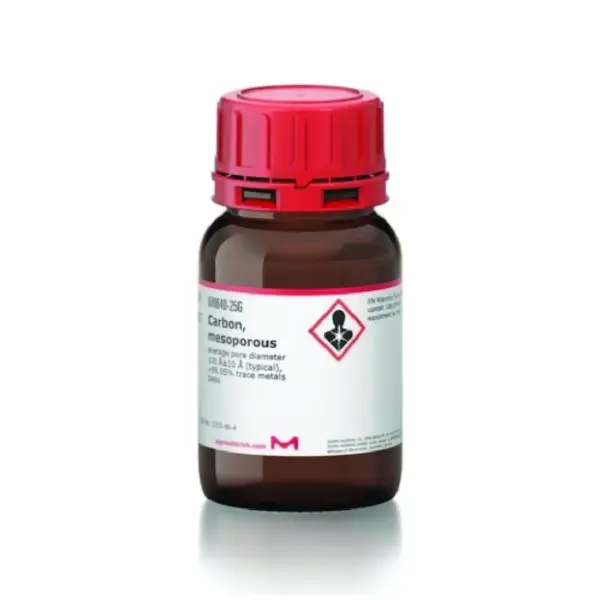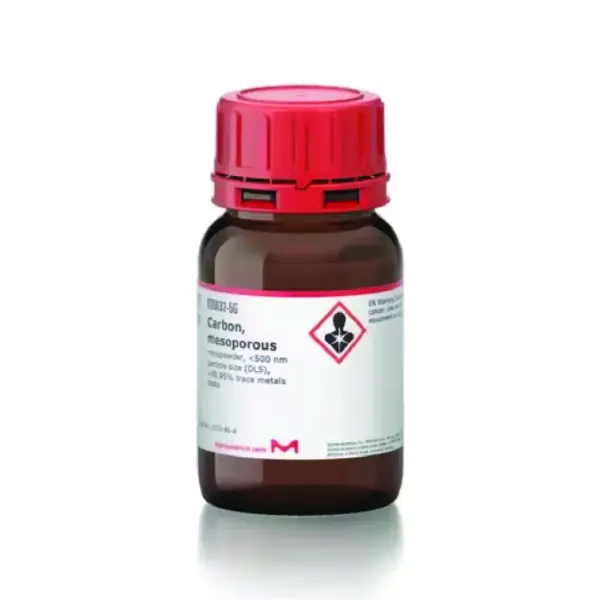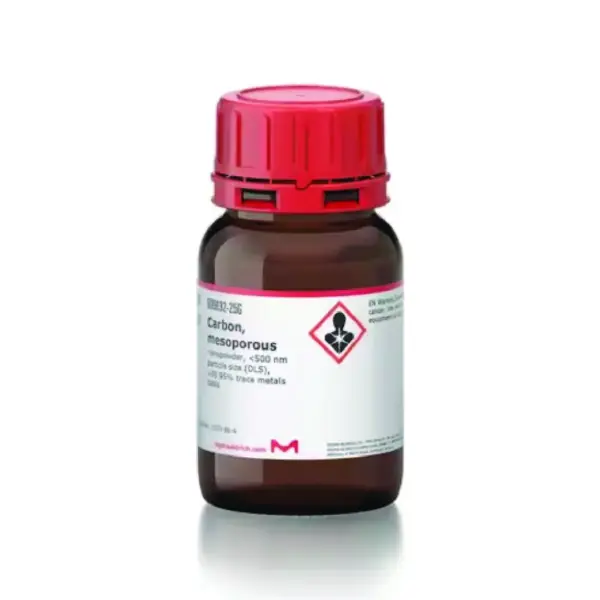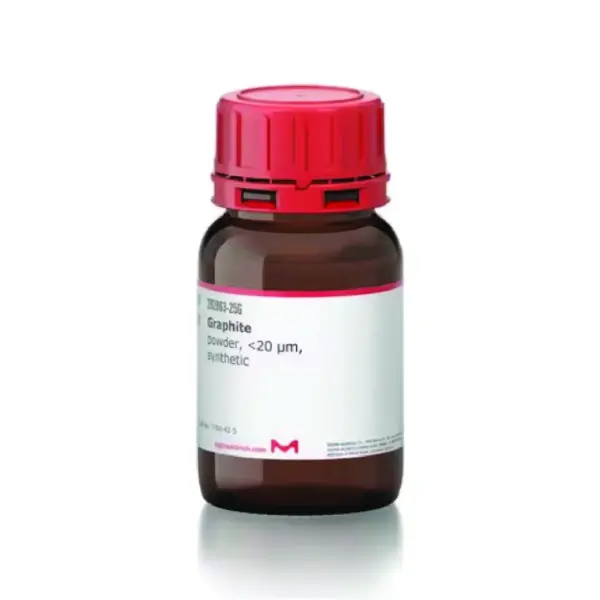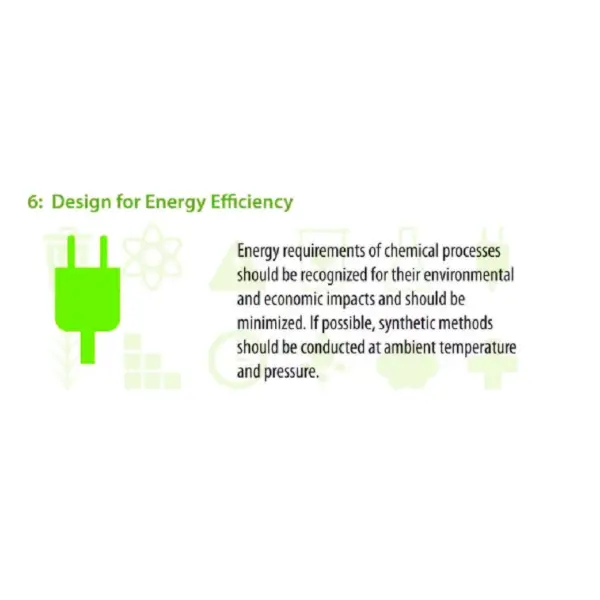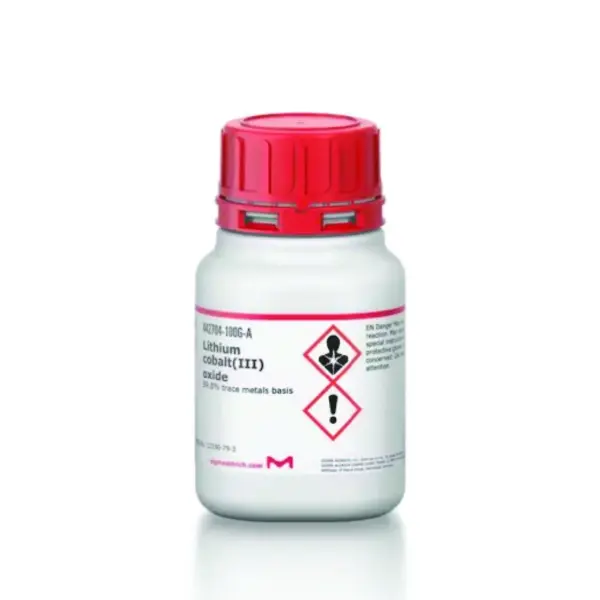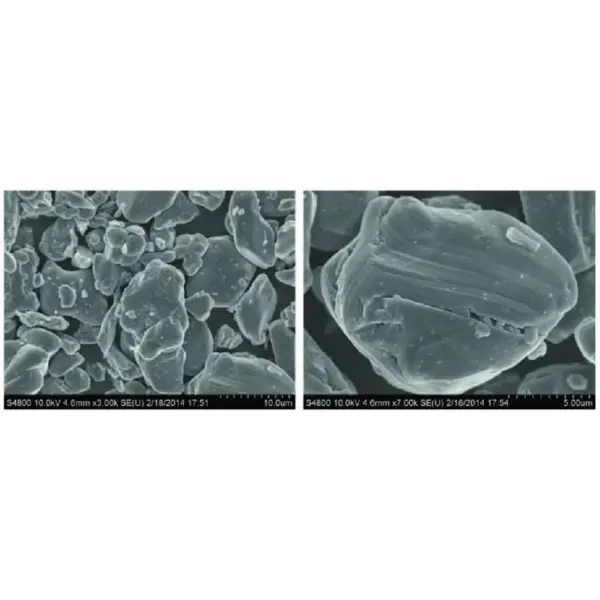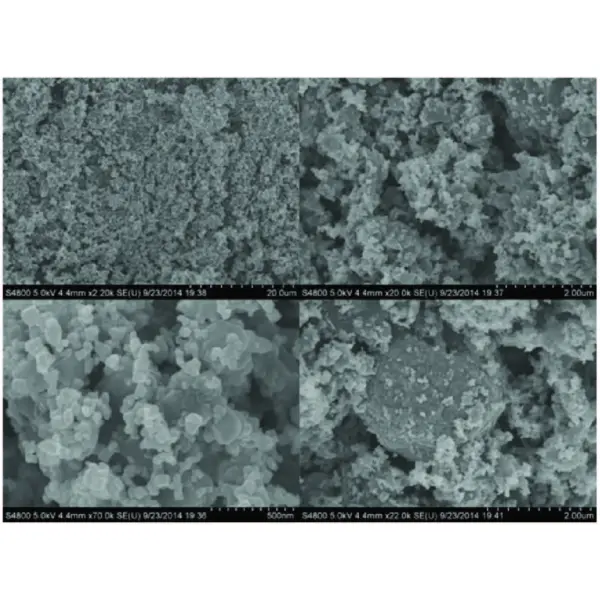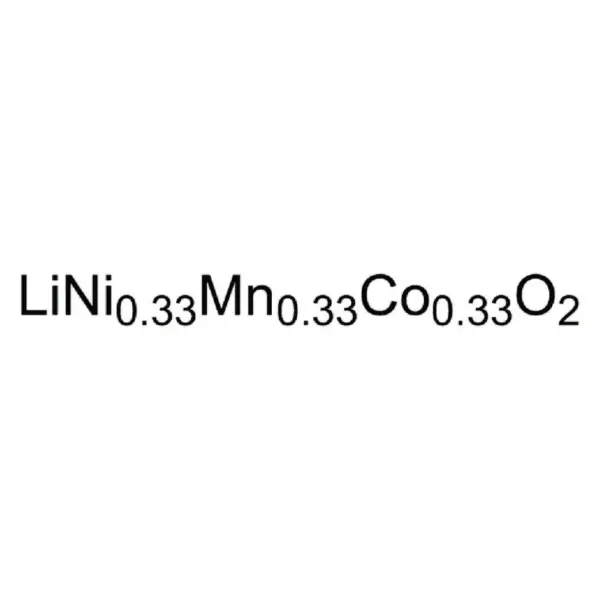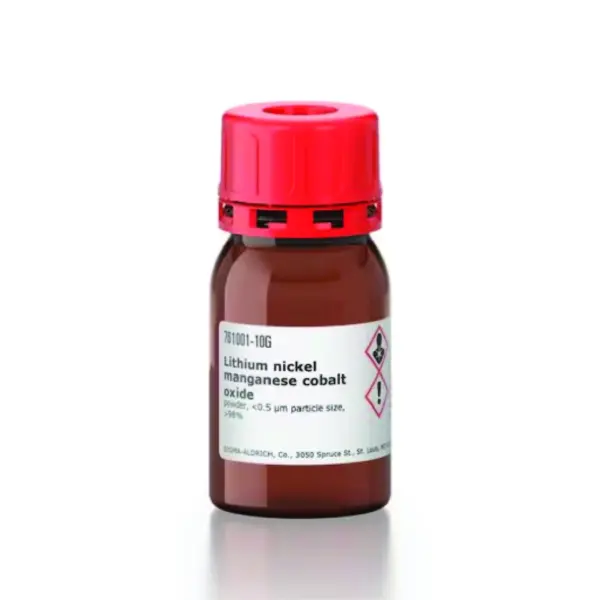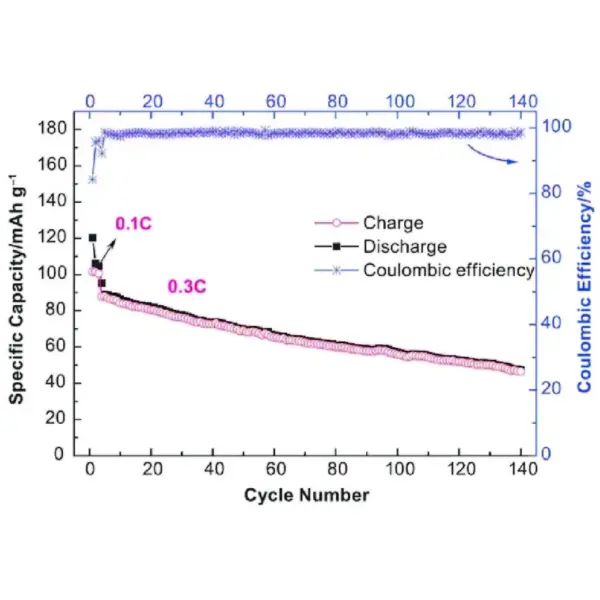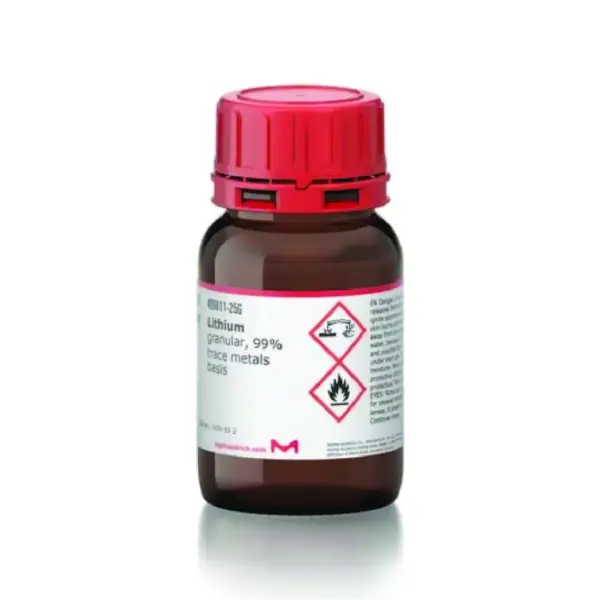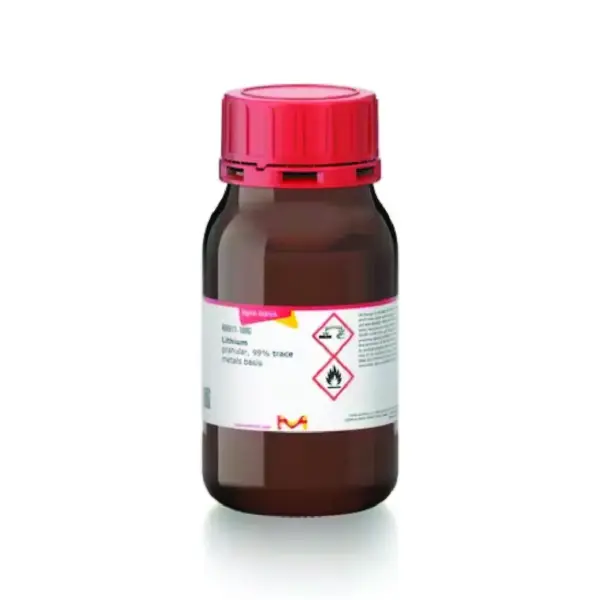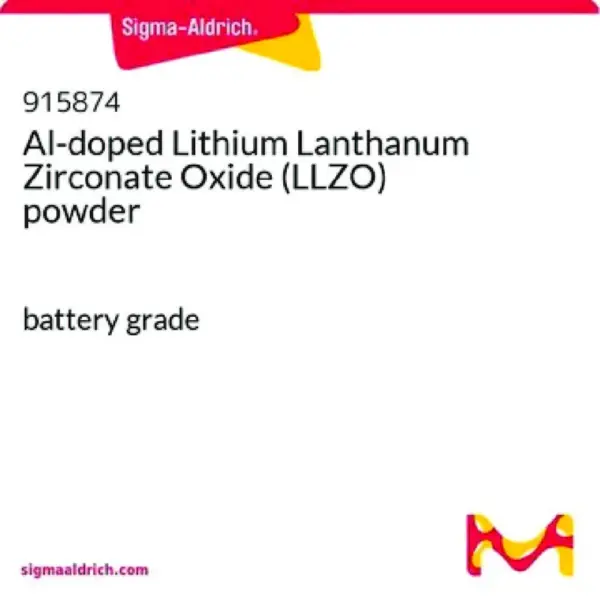
Al-doped lithium lanthanum zirconium oxide LLZO – Sigma-Aldrich
RM2,456.00Brand:
Sigma-Aldrich
Synonyms
Aluminum-doped cubic garnet LLZO, LLZALO
General Description
Battery-grade Al-doped Lithium Lanthanum Zirconate Oxide (LLZO) powder is a high-purity, inorganic material that is specifically designed for use in advanced battery applications. It is a white, crystalline powder with an average particle size of 5-6 microns and is composed of lithium, lanthanum, zirconium, oxygen, and a small amount of aluminum dopant. This material is known for its high ionic conductivity, which falls within the range of 0.01-0.1 mS/cm, making it an ideal electrolyte material for use in solid-state lithium-ion batteries. Moreover, the high purity and narrow particle size distribution of this powder make it well-suited for use in the precise and reproducible manufacturing of battery components.
Applications
The primary application of Al-doped LLZO powder is in all-solid-state and hybrid electrolytes for lithium-ion batteries. The unique combination of properties, including its high lithium-ion conductivity, robust chemical stability, and wide electrochemical stability window, make it a promising candidate for the next generation of solid-state batteries. This material has the potential to replace the conventional liquid electrolyte in lithium-ion batteries, offering higher energy density, improved safety, and longer lifespan. films.
Features & Benefits
Our LLZO powder provides high ionic conductivity and consistent particle size for reproducible results.
- Improved Battery Safety
- Increased Energy Density
Carbon nanotube, multi-walled – Sigma-Aldrich
RM2,025.00Brand:
Sigma-Aldrich
Synonyms
MWCNT, MWNT, Multiwall carbon nanotube
Cas No.
308068-56-6
General Description
Carbon nanotubes are hollow cylinders of carbon atoms. They are rolled-up graphene sheets with carbon atoms covalently bonded to each other through hybridisation. Owing to their excellent mechanical and electrical properties, they are widely used in the field of flexible and wearable electronic devices.
Application
Multi-walled carbon nanotubes (MWCNTs) functionalized with a polymer blend can be used as a hybrid catalyst for the degradation of crystal violet under visible light.
Due to their high magnetic sensitivity, MWCNT/manganese–zinc ferrite nanocomposites can be used in integrated nanoscale electronic systems.
They can also be used to fabricate sensors for strain-sensing applications because of their high mechanical flexibility and stability.
Features & Benefits
- Excellent conductivity
- Light weight
- Chemical stability
- Large surface area
- High mechanical strength
Preparation Note
Chemical Vapour Deposition (CVD) Method
Carbon nanotube, single-walled, ≥98% carbon basis, avg. no. of layers, 1 – Sigma-Aldrich
RM2,696.00Brand:
Sigma-Aldrich
Synonyms
Graphitized carbon black
Cas No.
308068-56-6
Application
- Electrode in power storage devices.
- Additives in structural materials.
- Flexible electronic materials.
Preparation Note
Super-growth (SG) method.
Carbon, mesoporous – Sigma-Aldrich
RM1,602.00Brand:
Sigma-Aldrich
Synonyms
Starbon™ 800
Cas No.
1333-86-4
General Description
Starbon™ is mesoporous carbon synthesized by the carbonization of expanded mesoporous starch at high temperatures. Amylose and amylopectin polymer chains in starch self assemble to form large mesoporous structures. Starbon materials exhibit tunable surface energies and high volume. It can be readily functionalized. The unique features are hydrophobicity, graphite-like surface and chemical inertness.
We are committed to bringing you Greener Alternative Products, which adhere to one or more of The 12 Principles of Greener Chemistry. This product has been enhanced for energy efficiency. Find details here.
Application
Starbons: Cooking up Nanostructured Mesoporous Materials
Carbon, mesoporous can be used in the fabrication of optoelectronic and energy storage devices such as supercapacitor, and lithium ion batteries. It can also be used in the formation of a hybrid support that acts as a green tool for water purification. It is a surface tunable material that finds usage in chromatography, catalysis and environmental remediation.
Starbons may be used as a stationary phase for liquid chromatography and as a solid support for a precious metal catalyst. Starbon supported Pd catalyst was used in a model Heck reaction of iodobenzene.
Other Notes
Read about the recent breakthrough in carbon capture
Legal Information
Starbon is a trademark of University of York
Carbon, mesoporous, less than 100 ppm Al, Ti, Fe, Ni, Cu, and Zn combined – Sigma-Aldrich
Price range: RM1,789.00 through RM3,341.00Brand:
Sigma-Aldrich
Synonyms
Graphitized carbon black
Cas No.
1333-86-4
General Description
Carbon, mesoporous is a carbonaceous material with high surface area, chemical inertness, biocompatibility, thermal stability and electrical conductivity. It can be prepared by a variety of methods such as hydrogen bonding interaction, and freeze drying. Mesoporous carbon materials have been categorized based on their pore diameter (2 nm < pore size < 50nm).
We are committed to bringing you Greener Alternative Products, which adhere to one or more of The 12 Principles of Greener Chemistry. This product has been enhanced for energy efficiency. Find details here.
Application
Carbon, mesoporous can be used for a variety of applications such as fuel cell, lithium ion batteries, lithium sulfur batteries, double-layer capacitor and hydrogen evolution.
Carbon, mesoporous, nanopowder, less than 500 ppm Al, Ti, Fe, Ni, Cu, and Zn combined – Sigma-Aldrich
Price range: RM313.22 through RM888.28Brand:
Sigma-Aldrich
Synonyms
Graphitized carbon black
Cas No.
1333-86-4
General Description
We are committed to bringing you Greener Alternative Products, which adhere to one or more of The 12 Principles of Greener Chemistry. This product has been enhanced for energy efficiency. Find details here.
Application
Carbon, mesoporous can be used for a variety of applications such as fuel cell, lithium ion batteries, lithium sulfur batteries, double-layer capacitor and hydrogen evolution.
It was used for a comparative study of the toxicity effect of carbon nanoparticles on C57BL/6 mice.
Graphite, powder, <20 μm, synthetic - Sigma-Aldrich
Price range: RM362.00 through RM519.00Brand:
Sigma-Aldrich
Synonyms
carbon allotrope
Cas no.
7782-42-5
General Description
Graphite is an allotrope of carbon. Graphite is a nonmetallic showing high electrical conductivity. Synthetic graphite can be prepared by heating carbonaceous precursor in an inert atmosphere.
Graphite is the most stable allotrope of carbon under standard conditions.The only nonmetallic conductor of electricity. Graphite powder is used as an additive to alter the magnetorheology and electrical conductivity of magnetorheological elastomers (MREs).
Application
Graphite powder has been used:
- in the synthesis of single sheet graphene nanoflakes
- in the preparation of graphite based magnetorheological elastomers
- free standing film like cantilever sensor in piezoelectric device
- to study its use as a catalyst for wet peroxide oxidation.
Oxidation of carbon dust was studied.
Synthesis of graphite based MR elastomers have been reported.[2] It may be used in the preparation of graphite oxide and anode in lithium ion battery.
Hard carbon, electrode sheet, copper substrate, size 5 in. × 10 in. – Sigma-Aldrich
RM1,299.00Brand:
Sigma-Aldrich
Synonyms
Hard carbon anode, Sodium-ion anode
General Description
Hard carbon electrode sheet is an electrode film of activated carbon cast on copper. Hard carbon is a low-density material with extremely high microporosity. Standard electrode sheets are 5 inches x 10 inches (127 mm x 254 mm) and cast single-sided on 10 µm thick copper foil current collectors. The composition of the electrode film is 90% graphite, 5% poly(vinylidene fluoride) [PVDF] and 5% Super P. PVDF acts as binder due to its thermal and electrochemical stability and strong adhesive properties.
We are committed to bringing you Greener Alternative Products, which adhere to one or more of The 12 Principles of Greener Chemistry. This product has been enhanced for energy efficiency. Click here for more information.
Application
Our hard carbon electrode sheet is a ready-to-use anode for alkali metal ion batteries such as sodium ion batteries (SIBs), lithium ion batteries (LIBs), and potassium ion batteries. Hard carbon is the anode of choice for sodium-ion batteries, where the use of graphite as an anode in SIBs is inhibited by the inability of sodium ions to form a binary graphite intercalation compound. Hard carbon offers a low insertion/deinsertion potential (~0.1 V Na/Na+) ideal for achieving high voltages. With an experimental capacity of 240 mAh/g and areal capacity of 2.32 mAh/cm2, our electrodes demonstrate outstanding electrochemical performance.
High-performance silicon anode, 1 micron silicon particles in crosslinked conducting polyanaline matrix – Sigma-Aldrich
RM1,961.00Brand:
Sigma-Aldrich
Synonyms
Doped polyaniline, Si encapsulated in 3D crosslinked polyaniline, Si/PANi composite, Silicon micron particle
General Description
Silicon is a most promising next generation lithium ion battery electrode material, due to its ~10 times higher specific capacity (3600 mAh/g) than graphite (372 mAh/g). However, silicon experiences large volume change (~400%) during lithium insertion, causing it to fracture and detach from current collector, rendering prototypical lithium-silicon batteries to lose most of their capacity in less than 10 charge-discharge cycles. A solution to the capacity and stability issues posed by the significant volume expansion upon lithiation of silicon is critical to the success of high capacity lithium ion batteries.
This silicon/PANi composite utilizes a doped, intrinsically conductive, 3D cross-linked polyaniline as matrix, which could function as both the conductive binder and the polymer electrolyte for silicon-based electrodes. Previous study for a similar silicon-based three-dimensional conducting polymer composite demonstrated increased electrochemically performance due to short diffusion paths and good 3D connectivity, and resulted in a marked improvement in cyclability, with over 90% capacity retention after 5,000 cycles.
This composite is made by encapsulating silicon particles in an in-situ polymerized 3D-crosslinked conductive polyaniline framework. This Si/PANi composite not only allows fast electrical and ionic transport, but also provides free space to allow giant volume expansion. This Si/PANi composite provides a ready-to-use electrochemically active silicon composite that would increase the capacity of conventional lithium ion battery, and improve the cycle-life of Si-based anodes
Lithium cobalt oxide, 99.8% trace metals basis – Sigma-Aldrich
RM1,029.00Brand:
Sigma-Aldrich
Synonyms
LCO, Lithium cobalt(III) oxide, Lithium cobaltite
General Description
Lithium cobalt(III) oxide is a class of electrode material that can be used in the fabrication of lithium-ion batteries. Lithium-ion batteries consist of anode, cathode, and electrolyte with a charge-discharge cycle. These materials enable the formation of greener and sustainable batteries for electrical energy storage.
We are committed to bringing you Greener Alternative Products, which adhere to one or more of The 12 Principles of Greener Chemistry. This product has been enhanced for energy efficiency. Find details here.
Applications
Critical substance in the quest for high performance, advanced batteries.
Lithium cobalt(III) oxide (LiCoO2) can be used as a cathode material with a specific capacity of ~274 mAhg−1 for the fabrication of lithium-ion batteries. Commercially, these LiCoO2 fabricated Li-ion batteries can be used in a majority of smartphones. LiCoO2 can also be used in the formation of fuel cells.

Lithium cobalt oxide, lithium-niobate coated LCO cathode active material – Sigma-Aldrich
RM1,060.00Brand:
Sigma-Aldrich
Synonyms
Lithium cobalt(III) oxide, LCO, LiNbO3-coated LCO, Lithium cobaltite
General Description
Lithium niobate coated lithium cobalt(III) oxide (LCO) is a powdered form of layered (R-3m) LiCoO2 with a typical particle size of 4-10 microns. The particles are coated in 5-10 nm, less than 1 wt.%, amorphous lithium niobate (also called lithium niobium oxide or LiNbO3).
Applications
LiNbO3-coated LCO is a high-performance cathode active material designed for lithium-ion batteries (LIBs), including solid-state and high-voltage batteries. As a classic layered cathode material, LiCoO2 serves as a model system for fundamental research while also delivered a high insertion potential and high capacity. The LiNbO3 coating significantly enhances cathode stability by protecting the electrode and electrolyte from undesired reactions. It mitigates reactions between the cathode material and electrolyte, reducing capacity fade and minimizing the release of metal ions from the LCO cathode. Additionally, the highly ionically conductive LiNbO3 improves rate capability by reducing the space charge layer barrier at the electrolyte/cathode interface, resulting in superior Li diffusion and reduced electrode polarization.
Features & Benefits
- LCO classic model system for fundamental research
- LiNbO3 coating safeguards cathode and electrolyte, enhancing coulombic
- LiNbO3 insertion layer enhances rate capability
Lithium nickel cobalt aluminium oxide, electrode sheet, aluminum substrate, size 5 in. × 10 in. – Sigma-Aldrich
RM7,160.00Brand:
Sigma-Aldrich
Synonyms
NCA
General Description
Lithium nickel cobalt aluminium oxide (NCA) is a class of electrode material that can be used in the fabrication of lithium-ion batteries. Lithium-ion batteries consist of anode, cathode, and electrolyte with a charge-discharge cycle. These materials enable the formation of greener and sustainable batteries for electrical energy storage.
We are committed to bringing you Greener Alternative Products, which adhere to one or more of The 12 Principles of Greener Chemistry. This product has been enhanced for energy efficiency. Find details here.
Applications
NCA is Aluminum doped Lithium nickel cobalt oxide (LNCO). Al doping is found very effective to suppress the cell impedance rise by stabilizing the charge-transfer impedance on the cathode side besides increasing the thermal stability of the material. NCA shows excellent electrochemical performance.
The NCA casted electrode sheets can be cut into appropriate size and is ready to be used in lithium ion batteries.
Other Notes
Crystal Structure: Rhombohedral
Operating Condiditons:
- Recommended maximum charge voltage: 4.3 V vs Li/Li+
- Recommended maximum charge current: 4C
- Recommended cut-off voltage for discharge: 3.0 V vs Li/Li+
- Recommended charge method: constant current – constant voltage
Lithium nickel cobalt aluminium oxide, powder, <0.5 μm particle size, >98% – Sigma-Aldrich
RM1,216.00Brand:
Sigma-Aldrich
Synonyms
NCA
General Description
Lithium nickel cobalt aluminium oxide (NCA) is a class of electrode material that can be used in the fabrication of lithium-ion batteries. Lithium-ion batteries consist of anode, cathode, and electrolyte with a charge-discharge cycle. These materials enable the formation of greener and sustainable batteries for electrical energy storage.
Lithium nickel cobalt mixed oxide which is a continuous solid solution series between lithium nickel oxide and lithium cobalt oxide is widely used as a positive electrode for Lithium Ion Batteries. Lithium nickel cobalt aluminium oxide (LNCA) belongs to this family of layered transition metal oxides and is used as a cathode in Lithium Ion batteries in plug-in electric hybrid vehicles. Aluminium substitution in the cathode increases the cycling and thermal stability.
We are committed to bringing you Greener Alternative Products, which adhere to one or more of The 12 Principles of Greener Chemistry. This product has been enhanced for energy efficiency. Find details here.
Applications
Lithium nickel cobalt aluminum oxide (LNCO) can be used as a thermally stable cathode material. It shows good cyclic performance and can be operated around 3.65V. It is further utilized in the fabrication of lithium-ion batteries for hybrid electric vehicles.
NCA is Aluminum doped Lithium nickel cobalt oxide (LNCO). Al doping is found very effective to suppress the cell impedance rise by stabilizing the charge-transfer impedance on the cathode side besides increasing the thermal stability of the material. NCA shows excellent electrochemical performance.
Features & Benefit
High specific reversible capacity, good cycling stability and good thermal stability.
Legal Information
Product of Engi-Mat Co.
Lithium nickel manganese cobalt oxide, electrode sheet, aluminum substrate, size 5 in. × 10 in. – Sigma-Aldrich
RM3,218.00Brand:
Sigma-Aldrich
Synonyms
NMC
General Description
Lithium nickel manganese cobalt oxide (NMC) is a class of electrode material that can be used in the fabrication of lithium-ion batteries. Lithium-ion batteries consist of anode, cathode, and electrolyte with a charge-discharge cycle. These materials enable the formation of greener and sustainable batteries for electrical energy storage.
We are committed to bringing you Greener Alternative Products, which adhere to one or more of The 12 Principles of Greener Chemistry. This product has been enhanced for energy efficiency. Find details here.
Applications
NMC electrode sheet has a layered structure and can be used as an active cathode material. It can further be used in combination with single electrolyte interphase (SEI) for the fabrication of lithium-ion batteries.
Other Notes
Crystal Structure: Rhombohedral
Operating Conditions:
- Recommended maximum charge voltage: 4.4 V vs Li/Li+
- Recommended maximum charge current: 1C
- Recommended cut-off voltage for discharge: 2.7 V vs Li/Li+
- Recommended maximum discharge current: 1 C
- Recommended charge method: constant current – constant voltage

Lithium nickel manganese cobalt oxide, lithium-niobate coated NMC532 cathode active material- Sigma-Aldrich
RM1,060.00Brand:
Sigma-Aldrich
Synonyms
LiNbO3-coated NMC532, NMC532
General Description
Lithium niobate coated NMC532 is a powdered form of lithium nickel manganese cobalt oxide with a stoichiometry of 5:3:2 Ni:Mn:Co and a typical particle size of 4-10 microns. The particles are coated in 5-10 nm amorphous lithium niobate, less than 1 wt.%.
Applications
LiNbO3-coated NMC532 is a high-performance cathode active material designed to be used in lithium-ion batteries (LIBs), particularly solid-state batteries and high-voltage LIBs. NMC532 balances the high capacity bestowed by 50% nickel with the structural stability imparted by the manganese and cobalt. Compared to NMC811, NMC532 tends to achieve better cycling lifetime and coulombic efficiencies. The LiNbO3-coating boosts the stability of the cathode material by protecting the electrode and electrolyte from unwanted reactions. Research indicates that the lithium-niobate coating, increases the capacity over time (less capacity fade) by mitigating reactions between the electrolyte and cathode material and by impeding the release of metal ions from the NMC cathode into the electrolyte. Additionally, the lithium-niobate coating, sometimes called a LiNbO3 insertion layer, improves the rate capability by reducing the space charge layer barrier at the electrolyte/cathode interface. This improvement is evidenced both in enhanced Li diffusion and smaller electrode polarization.
Features & Benefits
- NMC532 balances high capacity and long cycle lifetimes
- LiNbO3 coating protects the cathode and electrolyte, improving coulombic efficiency
- LiNbO3 insertion layer improves rate capability

Lithium nickel manganese cobalt oxide, lithium-niobate coated NMC622 cathode active material – Sigma-Aldrich
RM1,060.00Brand:
Sigma-Aldrich
Synonyms
LiNbO3-coated NMC622, NMC622
General Description
Lithium niobate coated NMC622 is a powdered form of lithium nickel manganese cobalt oxide with a stoichiometry of 6:2:2 Ni:Mn:Co and a typical particle size of 4-10 microns. The particles are coated in 5-10 nm amorphous lithium niobate, less than 1 wt.%.
Applications
LiNbO3-coated NMC622 is a high-performance cathode active material specially designed for lithium-ion batteries (LIBs), particularly solid-state and high-voltage batteries. With a balance of 60% nickel for high capacity and 40% manganese and cobalt for structural stability, NMC622 surpasses NMC811 in terms of cycling lifetime and coulombic efficiencies and offers higher capacity than NMC532. The LiNbO3 coating plays a vital role in enhancing the stability of the cathode material by safeguarding the electrode and electrolyte from undesired reactions. Research suggests that this lithium-niobate coating mitigates reactions between the cathode material and electrolyte, reducing capacity fade over time and impeding the release of metal ions from the NMC cathode. Additionally, the LiNbO3 “insertion layer” improves rate capability by minimizing the space charge layer barrier at the electrolyte/cathode interface. This advancement translates to superior Li diffusion and reduced electrode polarization.
Features & Benefits
- NMC622: High capacity and long cycle lifetimes
- LiNbO3 coating: Enhanced protection for cathode and electrolyte, leading to improved coulombic efficiency
- LiNbO3 insertion layer: Boosts rate capability

Lithium nickel manganese cobalt oxide, lithium-niobate coated NMC811 cathode active material – Sigma-Aldrich
RM1,060.00Brand:
Sigma-Aldrich
Synonyms
LiNbO3-coated NMC811, NMC811
General Description
Lithium niobate coated NMC811 is a powdered form of lithium nickel manganese cobalt oxide with a stoichiometry of 8:1:1 Ni:Mn:Co and a typical particle size of 4-10 microns. The particles are coated in 5-10 nm amorphous lithium niobate, less than 1 wt.%. Our NMC811 has a minimum nickel content of 80.0% of the metal content (≥48.2 wt% overall), translating to a nickel-rich composition between NMC811 and NMC85:05:10.
Applications
Lithium niobium oxide-coated NMC811 is a high-performance cathode material for solid-state and high-voltage lithium-ion batteries (LIBs). With 80% nickel content, NMC811 offers superior specific energy compared to NMC111, NMC532, or NMC622. The LiNbO3 coating enhances cathode stability by protecting the electrode and electrolyte from undesired reactions. Research suggests that this coating reduces capacity fade over time and restricts the release of metal ions from the NMC cathode, mitigating reactions with the electrolyte. The LiNbO3 “insertion layer” further improves rate capability by minimizing the space charge layer barrier at the electrolyte/cathode interface, leading to enhanced Li diffusion and reduced electrode polarization.
Features & Benefits
- NMC811 gives high specific energy density
- LiNbO3 coating safeguards cathode and electrolyte, enhancing coulombic efficiency
- LiNbO3 insertion layer enhances rate capability
Lithium nickel manganese cobalt oxide, powder, <0.5 μm particle size, >98% – Sigma-Aldrich
RM1,257.00Brand:
Sigma-Aldrich
Synonyms
NMC
General Description
Lithium nickel manganese cobalt oxide (NMC) is a class of electrode material that can be used in the fabrication of lithium-ion batteries. Lithium-ion batteries consist of anode, cathode, and electrolyte with a charge-discharge cycle. These materials enable the formation of greener and sustainable batteries for electrical energy storage.
We are committed to bringing you Greener Alternative Products, which adhere to one or more of The 12 Principles of Greener Chemistry. This product has been enhanced for energy efficiency. Find details here.
Applications
NMC is a novel lithium insertion electrode material for advanced lithium-ion batteries. Mn doping significantly increases the thermal stability besides increasing the electrochemical charge-discharge behavior.
NMC111 (lithium nickel-manganese-cobalt oxide with a stoichiometry of 1:1:1) is a promising cathode material used in advanced lithium-ion batteries, particularly for electric vehicle applications, due to its high energy density and long cycle life. NMC111 powder has a layered crystal structure that enables efficient, reversible lithium-ion diffusion, which is essential for good electrochemical performance. Manganese doping improves the thermal stability of the material while enhancing its electrochemical charge-discharge behavior. Compared to other NMC materials, NMC111 has a higher thermal stability and is less prone to thermal runaway, making it a safer option for battery applications.
Features & Benefits
Our NMC111 has engineered improvements over other LiNMC materials including thermal stability and high conductivity:
- More Reliable
- Longer Cycle Life
- Bulk and Pilot Scale Available
Legal Information
Product of Engi-Mat Co.
Lithium, granular, 99% trace metals basis – Sigma-Aldrich
Price range: RM534.00 through RM1,736.00Brand:
Sigma-Aldrich
Synonyms
Lithium atom, Lithium element
General Description
Granular lithium is a form of lithium metal that has been ground into small granules. Lithium is a soft, silver-white metal that is highly reactive and flammable. Lithium has a low density of 0.534 g/cm3, which makes it one of the lightest metals. Like the other alkali metals, lithium has a low melting point (180 °C) and is a good conductor of electricity and heat. Granular lithium is highly reactive and behaves as a strong reducing agent. It must be handled with caution due to its potential to ignite or explode. Lithium reacts readily with water and oxygen to form lithium hydroxide and lithium oxide, respectively, and even reacts with nitrogen gas at room temperature, forming lithium nitride. Typically, lithium is stored in an argon glovebox and airtight containers to prevent exposure to moisture, air, and nitrogen. To make granular lithium, the metal is first extracted from ores such as spodumene or lepidolite using a process called lithium carbonate conversion. After the lithium has been purified to a high degree of purity, it is milled into granules by rotating blades.
Lithium is a low-density alkali metal that is widely used as an anode material in rechargeable and non-rechargeable batteries. It is also used to alloy with aluminum and magnesium to make them stronger and lighter.
Applications
Lithium can be used as:
- A precursor to synthesize Li-based alloys such as LiAl and LiSi alloys, which are applicable as anode materials in the field of energy conversion and storage.
- A reducing agent in the reduction of zirconium oxide compounds in molten LiCl salt.
- As starting material to synthesize a reducing agent(1,4-bis(trimethylgermyl)-1.4-dihydropyrazine), for the fabrication of nickel metal films.
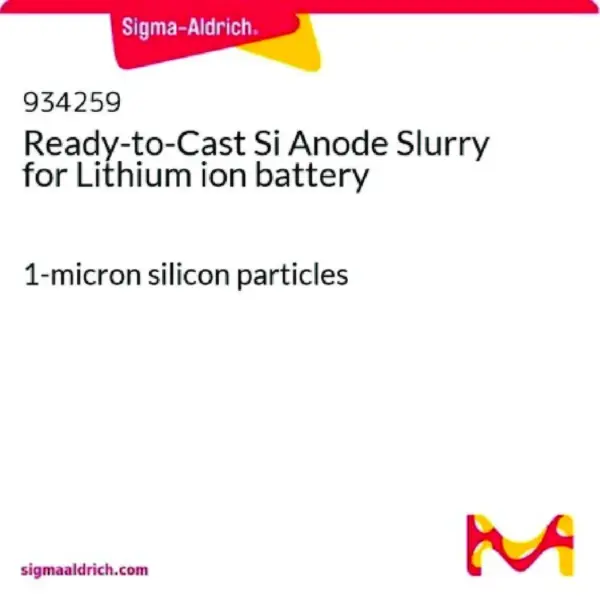
Ready-to-Cast Si Anode Slurry for Lithium ion battery, 1-micron silicon particles – Sigma-Aldrich
RM1,041.00Brand:
Sigma-Aldrich
Synonyms
Ready-to-Cast Si Anode Slurry for Lithium ion battery, Silicon anode slurry
General Description
Our ready-to-cast silicon anode slurry is a liquid-type dispersion, composed of high-purity 1-micron sized silicon particles, conductive additives, binder (poly(acrylic acid)), and water. The product features a high silicon loading content and excellent stability, ensuring superior performance and uniformity in battery fabrication.
Application
Our ready-to-cast silicon anode slurry is specifically designed to enable the production of high-performance silicon anodes for lithium-ion batteries. The slurry can be easily coated onto copper foil current collectors using blade-coating or slot-die coating techniques. Due to the precise formulation of our slurry, it is stable and processable, ensuring uniform and defect-free films of silicon anode material.The high silicon loading content and excellent stability of our ready-to-cast silicon anode slurry result in superior battery performance. Researchers can readily use our slurry to optimize their lithium-ion battery fabrication process, resulting in high-performance batteries suitable for a variety of applications.
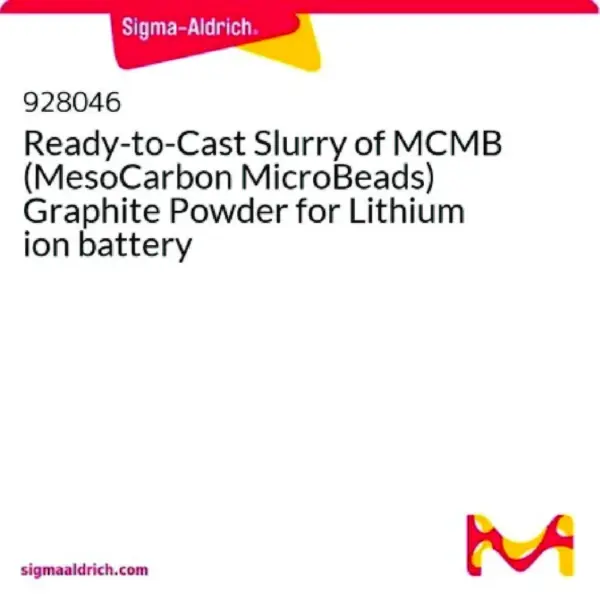
Ready-to-Cast Slurry of MCMB (MesoCarbon MicroBeads) Graphite Powder for Lithium ion battery – Sigma-Aldrich
RM2,441.00Brand:
Sigma-Aldrich
Synonyms
Blade coatable ink slurry for Lithium ion battery
Applications
The liquid-type dispersion is made up of a common active material, a conductive agent, a binder and a solvent that researchers can readily use for processing lithium-ion battery electrodes.
Silicon, nanoparticles, 40 nm avg. part. size, ≥99% trace metals basis – Sigma-Aldrich
RM2,072.00Brand:
Sigma-Aldrich
Synonyms
SiNPs, Silicon nanopowder
Cas no.
7440-21-3
General Description
Our 40 nm silicon nanoparticles are a high-quality, ultrafine powder with a narrow particle size of 40 nm and a high surface area (~100 m2/g). It is produced by the laser gas phase synthetic method from high-purity silane to achieve the high purity (>9=9%) and reliable particle size.
We are committed to bringing you Greener Alternative Products, which belongs to one of the four categories of greener alternatives. This product has been enhanced for energy efficency. Click here for more information.
Application
Silicon nanopowder is a promising material for use in advanced battery technologies. With its high theoretical capacity (4212 mAh/g), it has the potential to significantly improve the performance of lithium-ion batteries. The controlled particle size and high surface area of our silicon nanopowder make it an ideal candidate for use as an anode material in these batteries, allowing for improved charge and discharge rates, longer cycle life, and higher energy densities. Additionally, silicon nanopowder is being researched for use in other types of batteries, including lithium-air and lithium-sulfur batteries. Its unique properties make it a valuable material for developing next-generation battery technologies that offer higher performance, longer lifetimes, and lower costs.
Features and Benefits
Our silicon nanoparticles are designed for battery applications to extend cycle life and charge and discharge rates. We offer:
- Low Particle Size
- High Surface Area
- Consistent Quality
Silicon, nanoparticles, nanoparticles, 10 nm avg. part. size, ≥99% trace metals basis, battery grade – Sigma-Aldrich
RM3,104.00Brand:
Sigma-Aldrich
Synonyms
SiNPs, Silicon nanopowder
Cas No.
7440-21-3
General Description
Our 10 nm silicon nanoparticles are a high-quality, ultrafine powder with a narrow particle size of 10 nm and a high surface area (~180 m2/g). It is produced by the laser gas phase synthetic method from high-purity silane to achieve high purity (>=99%) and a reliable particle size.
We are committed to bringing you Greener Alternative Products, which belong to one of the four categories of greener alternatives. This product has been enhanced for energy efficiency. Click here for more information.
Application
Silicon nanopowder is a promising material for use in advanced battery technologies. With its high theoretical capacity (4212 mAh/g), it has the potential to significantly improve the performance of lithium-ion batteries. The controlled particle size and high surface area of our silicon nanopowder make it an ideal candidate for use as an anode material in these batteries, allowing for improved charge and discharge rates, longer cycle life, and higher energy densities. Additionally, silicon nanopowder is being researched for use in other types of batteries, including sodium-ion and magnesium-ion batteries. Its unique properties make it a valuable material for developing next-generation battery technologies that offer higher performance, longer lifetimes, and lower costs.
Features & Benefits
Our silicon nanoparticles are designed for battery applications to extend cycle life and charge and discharge rates. We offer:
- Lowest Particle Size
- High Surface Area
- Consistent Quality
Silicon, wafer, <111>, P-type – Sigma-Aldrich
RM818.00Brand:
Sigma-Aldrich
Synonyms
Silicon element
Cas No.
7440-21-3
General Description
0 vortex defects. Etch pitch density (EPD) < 100 (cm-2). Resistivity 10-3 – 40 Ωcm
Oxygen content: <= 1~1.8 x 1018 /cm3; Carbon content: <= 5 x 1016 /cm3; Boule diameter: 1~8 ″
We are committed to bringing you Greener Alternative Products, which belong to one of the four categories of greener alternatives. This enabling product has been enhanced for energy efficiency. Click here for more information.

